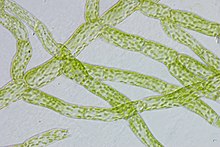Apex cell

Protonema cells of the deciduous moss Physcomitrella patens . The apex cell is in the lower left corner of the picture.
An apical cell is at plant an organism cell at the head of a thallus , a shoot or a root . It releases cells, called segments, in a regular sequence, but does not change their shape.
- Single-edged apex cells give off cells in one direction only, cell threads are formed, for example in the protonema of the moss
- Double-edged apex cells result in flat structures, for example in thaless liverworts or leaves of deciduous mosses . These vertex cells are wedge-shaped and subdivide segments on two sides.
- Three-edged parietal cells sit on the tip of the shoot of many mosses and ferns . They have the shape of a tetrahedron , with one surface facing the tip. The other three pages in turn subdivide segments.
- Four-edged apex cells are found in the tip of the roots of ferns.
Parietal cells occur in many algae , moss, horsetail and many ferns. Some vascular spore plants , especially the bear moss family , as well as the seed plants do not have apex cells, they grow with meristems .
literature
- Gerhard Wagenitz : Dictionary of botany. The terms in their historical context . 2nd expanded edition. Spectrum Academic Publishing House, Heidelberg / Berlin 2003, ISBN 3-8274-1398-2 , p. 287 .
- Peter Sitte , Elmar Weiler , Joachim W. Kadereit , Andreas Bresinsky , Christian Körner : Textbook of botany for universities . Founded by Eduard Strasburger . 35th edition. Spektrum Akademischer Verlag, Heidelberg 2002, ISBN 3-8274-1010-X , p. 119 .
References
- ↑ Ralf Reski (1998): Development , genetics and molecular biology of mosses . Botanica Acta 111, 1-15.